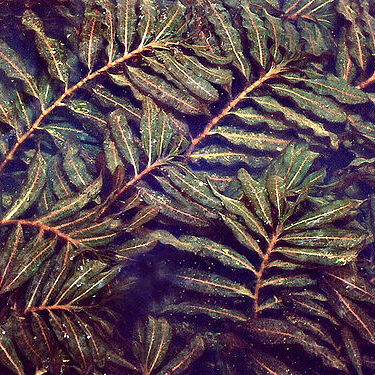Aquatic perennial or annual herbs, often rhizomatous. Stems erect, floating or creeping, often producing turions (propagules in the form of buds). Leaves submerged and/or floating with a distinct midrib, alternate, those subtending inflorescences often subopposite, simple, stem clasping, sessile or petiolate; margins entire or crisped; apex obtuse to acute. Stipules adnate to blade or free. Inflorescence erect, usually emergent, a pedunculate spike, capitulate to cylindric, with 2–many flowers. Peduncle often bent when fruiting, submerging the fruit. Flowers actinomophic, tetramerous, bisexual. Perianth segments 4, free. Stamens usually 4, epipetalous; filaments adnate to perianth segments; anthers bilocular, extrose, dehiscing by longitudinal slits. Ovary superior; carpels 2–4, free. Fruit usually interpreted as drupelet, rarely as nutlet or berry. Embryo coiled inside fruit.
Herbs, perennial or rarely annual, rhizomatous or not rhizomatous, caulescent; turions absent or present. Leaves alternate or nearly opposite, submersed or both submersed and floating, sessile or petiolate; sheath not persisting longer than blade, not leaving circular scar when shed, ligulate, not auriculate, or rarely auriculate; intravaginal squamules scales, more than 2. Inflorescences terminal or axillary, spikes, capitate spikes, or panicles of spikes, not subtended by spathe, pedunculate; peduncle not elongating, not spiraling following fertilization. Flowers bisexual; subtending bracts absent; tepals 4 in 1 series; stamens [2 or] 4, epitepalous, in 1 series; anthers distinct, dehiscing vertically; pollen spheric; pistils 1 or 4, mostly not stipitate, rarely short-stipitate; ovules marginal, orthotropous. Fruits drupaceous. Seeds 1; embryo curved.
Submerged, dioecious or monoecious, rhizomatous,aquatic, salt-tolerant, annuals or perennials, with slender capillary stems.Rhizomes with scale leaves and erect leafy shoots at nodes. Leaves opposite,pseudowhorled or alternate, linear, simple, entire; sheathing base present or absent,ligulate, with ligule sometimes longer than sheath. Flowers unisexual,axillary, solitary or clustered. Perianth cup-like, reduced to a few smallscales, or absent. Stamens 1–3, fused if more than 1 into a single anther mass,4-, 8-or 12-sporangiate; pollen globose. Carpels 1–9, free; style simple,usually persistent; stigma conspicuous, funnel-shaped to spathulate; ovule 1,pendulous. Fruit an achene.
Herbs, perennial or annual, in fresh to brackish water, totally submerged or with floating leaves. Rhizomes present or absent. Stems elongated or shortened, terete to compressed, rarely strongly compressed. Leaves alternate or basal, occasionally opposite or subopposite; stipules free from leaves or adnate to leaf base and sheathing stems. Inflorescence a capitate spike, terminal or axillary. Plants monoecious; flowers small, bisexual. Perianth bractlike, free, present or absent. Stamens (1-)4; anthers sessile, (1 or)2-celled, extrorse, longitudinally dehiscent. Carpels (1-)4, free; ovule solitary. Fruit drupaceous. Embryo curved; endosperm absent.
Leaves alternate or opposite, those immersed thin, those above water often leathery, sheathing at the base, sheath free or partially adnate to the petiole
Flowers hermaphrodite, small, arranged in pedunculate axillary spikes; peduncle surrounded by a sheath at the base; bracts absent
Carpels 4, free, 1-locular; stigmas sessile or on short styles; ovule solitary, on the adaxial angle
Stamens 4, inserted in the claws of the segments; anthers extrorse, 2-locular, sessile
Perianth of 4 free rounded shortly clawed valvate segments
Fruits free, 1-seeded, indehiscent
Aquatic herbs of fresh, water
Seeds without endosperm

